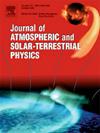探索地形和非地形重力波对北极平流层极地涡旋动力学和春季臭氧损失的影响
IF 1.9
4区 地球科学
Q3 GEOCHEMISTRY & GEOPHYSICS
Journal of Atmospheric and Solar-Terrestrial Physics
Pub Date : 2025-06-01
DOI:10.1016/j.jastp.2025.106538
引用次数: 0
摘要
由于北半球大陆面积大,北极平流层极涡(SPV)表现出强烈的年际变化,这也增强了地形和非地形重力波(GWs)的产生。在这项研究中,我们分析了近30年来用icoshedral Nonhydrostatic (ICON)模型进行的两个理想实验。一个实验涉及关闭地形波(NO_SSO),而另一个涉及关闭非地形波(NO_NON)。NO_NON实验的涡面积明显小于对照模拟(ICON-CTL),在相同水平上也小于NO_SSO实验。在这两个实验中,SPV的位置都比ICON-CTL更偏极,而NO_SSO的涡旋中心最靠近极点。NO_SSO实验在冬末早春表现出较强且稳定的涡旋,而NO_NON实验则表现出较小的涡旋面积和较短的寿命。NO_NON试验显示SPV破裂日变异性最大。ICON-CTL运行的极地平流层云(PSC)体积主要与ERA5一致,尽管它们略有高估。敏感性实验显示,与ICON-CTL相比,PSC体积更高,NO_SSO在冬末和早春期间保持显著较大的体积。ICON-CTL记录了30年间两次异常强涡(ESV)事件,而NO_NON没有记录;NO_SSO在同一时期出现了前所未有的13次ESV事件。本文章由计算机程序翻译,如有差异,请以英文原文为准。
Exploring the Impact of Orographic and Non-Orographic Gravity Waves on Arctic Stratospheric Polar Vortex Dynamics and Springtime Ozone Loss
The Arctic stratospheric polar vortex (SPV) exhibits strong interannual variability due to the large landmass in the Northern Hemisphere (NH), which also enhances the generation of orographic and non-orographic gravity waves (GWs). In this study, two idealized experiments with the ICOsahedral Nonhydrostatic (ICON) model over a 30-year period were analyzed. One experiment involved turning off orographic waves (NO_SSO), while the other one involved turned off non-orographic waves (NO_NON).
The NO_NON experiment exhibits a significantly smaller vortex area than the control simulation (ICON-CTL) and is also smaller than in the NO_SSO experiment at the same levels. In both experiments, the SPV is located more poleward compared to ICON-CTL, with the vortex center in NO_SSO being closest to the pole. The NO_SSO experiment demonstrates stronger and more stable vortices during late winter and early spring, while the NO_NON experiment shows a smaller vortex area and a shorter lifespan. The NO_NON experiment shows the highest variability in SPV breakup days.
The Polar Stratospheric Cloud (PSC) volumes in the ICON-CTL run are mainly consistent with ERA5, although they are slightly overestimated. The sensitivity experiments reveal higher PSC volumes compared to ICON-CTL, with NO_SSO maintaining significantly larger volumes during late winter and early spring. The ICON-CTL run included two exceptionally strong vortex (ESV) events over the 30-year period, while NO_NON recorded none; and NO_SSO showed an unprecedented frequency of 13 ESV events during the same period.
求助全文
通过发布文献求助,成功后即可免费获取论文全文。
去求助
来源期刊

Journal of Atmospheric and Solar-Terrestrial Physics
地学-地球化学与地球物理
CiteScore
4.10
自引率
5.30%
发文量
95
审稿时长
6 months
期刊介绍:
The Journal of Atmospheric and Solar-Terrestrial Physics (JASTP) is an international journal concerned with the inter-disciplinary science of the Earth''s atmospheric and space environment, especially the highly varied and highly variable physical phenomena that occur in this natural laboratory and the processes that couple them.
The journal covers the physical processes operating in the troposphere, stratosphere, mesosphere, thermosphere, ionosphere, magnetosphere, the Sun, interplanetary medium, and heliosphere. Phenomena occurring in other "spheres", solar influences on climate, and supporting laboratory measurements are also considered. The journal deals especially with the coupling between the different regions.
Solar flares, coronal mass ejections, and other energetic events on the Sun create interesting and important perturbations in the near-Earth space environment. The physics of such "space weather" is central to the Journal of Atmospheric and Solar-Terrestrial Physics and the journal welcomes papers that lead in the direction of a predictive understanding of the coupled system. Regarding the upper atmosphere, the subjects of aeronomy, geomagnetism and geoelectricity, auroral phenomena, radio wave propagation, and plasma instabilities, are examples within the broad field of solar-terrestrial physics which emphasise the energy exchange between the solar wind, the magnetospheric and ionospheric plasmas, and the neutral gas. In the lower atmosphere, topics covered range from mesoscale to global scale dynamics, to atmospheric electricity, lightning and its effects, and to anthropogenic changes.
 求助内容:
求助内容: 应助结果提醒方式:
应助结果提醒方式:


